List of hardy palms
Hardy palms are any of the species of palm (Arecaceae) that are able to withstand brief periods of colder temperatures and even occasional snowfall. A few palms are native to higher elevations of south Asia where true winter conditions occur, while a few others are native to the warmer parts of the temperate zone in North America. A few of these temperate climate palms can tolerate hard freezes with little or no damage. Many of these "hardy " species can be cultivated in warmer parts of temperate climates.
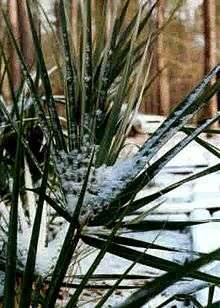
The cold hardiness of palms varies by species. The hardiest species are found in the tribe Trachycarpeae, Washingtonia, and Rhapis, with species which are found in the wild in areas where the mean temperature of the coldest month of the year is not much less that 5 °C (41 °F), and Trachycarpus, with species which are found in the wild in areas where the mean temperature of the coldest month of the year is as low as 0.2 °C (32.4 °F). Members of the above palms and other genera are sometimes grown in areas where they are not truly hardy, overwintering with the aid of various kinds of artificial protection. [1]
Fan palms
The fan palms (Arecaceae tribe Corypheae; palms with fan-shaped leaves) include all of the hardiest palms.
- Windmill Palms (Trachycarpus fortunei, T. takil) – is considered the most cold hardy palm in the world. These tough species are native to eastern China and the Himalaya mountains where severe (though brief) winter conditions occur. Hardy to about −23 °C (−10 °F), they grow at high altitudes where temperatures are cool. It is also tolerant of low summer temperatures. Mature Trachycarpus trees have been successfully grown in high latitude locations as far north as 58°N in northern Scotland. Mature specimens can also be found in the southern coast of Ireland, the southern coast of England, southwestern Canada (in the city of Vancouver and on Vancouver Island), Southern Switzerland (Ticino). Trachycarpus is also grown extensively in Japan, Australia, and New Zealand. In the United States Trachycarpus is cultivated along the Pacific coast and as far north as Washington State and along the Atlantic coast as far north as southern Connecticut. [2] Large mature specimens can be found from Maryland south to Georgia, though numbers decline toward southern Georgia south toward Florida. Across the interior of the United States, there are reports of long term specimens that have survived north to the Ohio River, with several long term plantings in the higher elevations of Tennessee and western North Carolina. It appears that areas west of the Mississippi River (the southern Plains) may be too hot in summer for successful long term cultivation.
- Bismarck Palm (Bismarckia nobilis) - Native to the island of Madagascar off the east coast of Africa this cold hardy palm is among the most sought after palms in Florida mainly due to its unique grey color and ability to withstand temperatures down to 15 f. This palm thrives in any sub-tropical environment. You will see this palm tree in states such as: Alabama, Arizona, Arkansas, California, Georgia, Louisiana, Mississippi, Nevada, and Texas. It is a very fast growing palm, and can go from 3 to 15 feet in just 5 years in the right environment. During late spring the tree will produce small, fragrant flowers. Once fully matured, it can reach heights of up to 70 feet in the wild, however most do not exceed 40 feet. This palm produces sharp thorns on the frond stalks, so one must take proper precautions while pruning.
- Mediterranean Fan Palm (Chamaerops humilis) – The only palm native to southern Europe besides the Cretan Date Palm, and very drought-tolerant. Hardy to −12 °C (10 °F), but does prefer hot summers. Despite the fact that this palm is less hardy than many palms listed here, it has the northernmost native habitat. It is found in abundance across most of southwestern Europe and northwestern Africa. It is a very slow-growing plant. The blue form of the species, native to high elevations of the Atlas Mountains, has recently been introduced into the trade and early reports indicate that it may be 5 °C (9 °F) or more degrees hardier than the green form.
- Needle Palm (Rhapidophyllum hystrix) – This clustering and usually trunkless palm is native to the subtropical southeastern United States, from central Florida to Georgia, Mississippi, South Carolina and Alabama in the United States. It is considered hardy to -23.3 C (-10 F), and is cultivated along the East Coast from Florida to southern Massachusetts, and along the West Coast from California to Seattle. They have proven hardy in the Tennessee valley region and up into the lower Ohio Valley. The needle palm is very slow-growing and rarely reaches heights of over 1 m (3 ft 3 in), though very old specimens in the deep south can reach 5 m (16 ft) in height and width. There are documented specimens that have been growing in White County, Tennessee, since the early part of the 1960s, as well as United States National Arboretum in the Asia Valley section, in the city of Washington D.C., that are at 3 m (9.8 ft) in height.
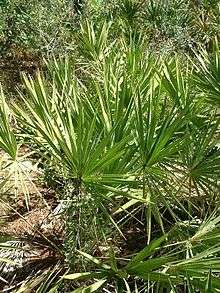
- Mazari Palm (Nannorrhops richtiana) – This palm, native to the dry, mountainous terrains of northern Pakistan, Afghanistan, Iran and surrounding regions, is also thought to be extremely cold hardy (perhaps to about −20 °C or −4 °F), though also requiring hot summers and dry soils. However, due to its limited availability in cultivation, not much is known about this palm. Mazari Palm is not easy to grow, perfect drainage and full sun are required for this palm to survive. This palm will not tolerate wet freezes.
- Saw Palmetto (Serenoa repens) - These palms are native to the southeastern United States, most commonly along the Atlantic and Gulf Coastal plains, but also as far inland as southern Arkansas, this bushy palm is hardy to about −15 °C (5 °F). This bushy palm grows in abundance within wetlands and subtropical grasslands of central and northern Florida. Extract from Saw Palmetto is often used to treat problems with the prostate.
- Sabal palms (palmettos; 13 species) – These palms are native to the southeastern United States, Mexico, Central America, and the Caribbean. The Cabbage Palmetto (Sabal palmetto), the state tree of both Florida and South Carolina, and is widely cultivated along the south Atlantic and Gulf of Mexico coast of the United States, and needs hot and humid summers to grow. The species is considered hardy to USDA Hardiness Zone 8, and may survive short periods of temperatures as low as −14 °C (7 °F). Large and older specimens can be found from southern Virginia south to Florida and west to Texas. There are a few documented smaller specimens of Sabal palmetto {cabbage palm} growing in zone 7b in southern Maryland, Delaware, and coastal Connecticut in the city of Bridgeport. [3]. The Mexican Palmetto (Sabal mexicana) is a close relative of the Cabbage Palmetto, native to southern Texas and northern Mexico.
- Dwarf Palmetto (S. minor) is considered hardy to USDA zone 6b, like the needle palm. It can tolerate short periods of temperatures as low as −29 °C (−20 °F). Endemic to the swamps and lowlands of the south Atlantic and Gulf of Mexico coast of the United States, it can stand long periods of heat and drought. Sabal minor is successfully cultivated across the entire southern United States below 35 latitude, and up the East Coast to 41 latitude and up the West Coast to 45 latitude.
- Caranday palm (Trithrinax campestris) is a South American arecaceae palm native of Uruguayan and northeastern Argentine sabanas. It is a very rustic palm that grows in arid, well drained, rocky soils. Its distinctive features are its compact shape, short green to grayish foliage, and trunk fully hidden by dry dead branches (coat) remaining from several previous seasons. It is very resistant to drought, and -9 °C/-15 °C temperatures when not in growing season, although it tends to shed its leaves in these conditions. It is one of the most cold-hardy palms in the world, because it also grows in the mountains of Sierras de Córdoba.
- Washingtonia palms (Washingtonia filifera, W. robusta) – These palms are native to southern California and northwest Mexico, growing as high as 30 m (98 ft) in their native habitat. California Washingtonia (W. filifera) is hardy to −12 °C (10 °F); it prefers a dry Mediterranean climate, though it still grows in areas with humid subtropical climates like Brisbane, Sydney, Houston, and New Orleans. It is sometimes grown in containers, or planted as short-term specimens in areas where it is not quite hardy. Mexican Washingtonia (W. robusta) is somewhat less hardy, native to northern Mexico (Baja California Peninsula). It has a more robust trunk and stiffer leaves than W. filifera, and is hardy to −10 °C (14 °F).
- Livistona australis – It is native to southeastern Australia.
- Rhapis excelsa – It is native to China and it is hardy to about −7 °C (19 °F).
Pinnate-leaved palms
Few palms with pinnate leaves tolerate much frost. They belong to several tribes of the Arecaceae, with the species listed here belonging to Tribe Areceae (Chamaedorea), Tribe Cocoseae (Butia, Jubaea) and Tribe Phoeniceae (Phoenix).
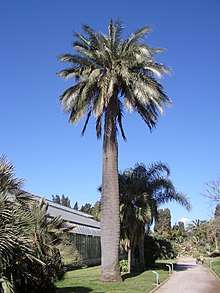
- Chilean Wine Palm (Jubaea chilensis) – A contender for the hardiest pinnate-leaved palm, it is hardy to about −12 °C (10 °F) and has been cultivated successfully as far north as Seattle, Washington, Vancouver, British Columbia, and London England. This palm does not perform well in hot, humid tropical climates.
- Butia Palm or Jelly Palm / Pindo Palm (Butia odorata (syn. B. capitata Hort.)[4][5]) – With Jubaea, possibly the hardiest known pinnate-leaved palm. B. odorata is a palm native to Brazil and Uruguay.[4] This palm grows up to 6 m (20 ft), exceptionally 8 m (26 ft), in a slow but steady manner. It is easily identifiable with beautiful pinnate leaves that arch outwards from a thick stout trunk. B. odorata is notable as one of the hardiest feather palms, tolerating temperatures down to about −10 °C (14 °F); it is widely cultivated in warm temperate regions. It is commonly grown on the East Coast of the United States as far north as Virginia Beach, Virginia and Portland and Seattle on the West coast. It thrives in humid subtropical climates. This tree is commonly known as the "jelly palm" because of the sticky, edible, date-like fruit it produces, which is used in many South American countries to make jelly.
- Butia eriospatha - Woolly Jelly Palm - Though it maybe more cold tolerant, in N. America it is not found in cultivation as much as B. ordorata. This maybe due to being native to a remote mountainous region of Southern Brazil, at altitudes of 1,000 m (3,300 ft). The weather is more similar to N. America's Pacific Northwest, with wet winters and cool summer days. [6]
- Chamaedorea microspadix and Chamaedorea radicalis – the hardiest known species in the genus Chamaedorea. Both species come from Mexico and are considered stem hardy to about −11 °C (12 °F), although they will lose their leaves at temperatures below about −6 °C (21 °F).
- Canary Island Date Palm (Phoenix canariensis) – This species is hardy to about −10 °C (14 °F), and is grown as far north as the south of England (50°N), producing viable seed (in Southsea, Hampshire). In North America mature specimens can be found as far north as Gold Beach, Oregon (42.5º N) on the West Coast, and Wilmington, North Carolina (35.2 N) on the East Coast. This palm is one of the most commonly grown palms in the world. Well adapted to low humidity and little watering, this palm is used as an ornamental in both Mediterranean climates and desert climates. In more humid climates, these trees will often be seen with sword ferns sprouting just beneath the crown.
- Cretan Date Palm (Phoenix theophrasti) – Another species of Phoenix which may show similar frost tolerance, native to Crete and southwest Turkey, but has not been adequately tested.
- Date Palm (Phoenix dactylifera) – This relative of the Canary Island date palm, and producer of the edible date, is also hardy to about −11 °C (12 °F), but does not tolerate very wet areas. This palm is one of the staple plants of the Middle East for its versatility and edible fruit.
- Mule Palm (× Butiagrus nabonnandii) – Hardy to about −10 °C (14 °F). Manmade hybrid between the Butia palm and Queen palm. One of the hardiest feather palms. It combines the hardiness of the Butia palm with the fast-growing, tropical fronds of the Queen palm. Mature specimens are quite rare due to the difficulty in producing this palm and the characteristics and cold tolerance of the palm is variable with each specimen. Many of them resemble coconut palms.
- Ceroxylon quindiuense – It is native to the Colombian Andes where it is found at 2,500–2,800 m (8,200–9,200 ft) above sea level. At this altitude it tolerates occasional frosts for short periods of time.
- Ceroxylon alpinum – It is native to the Andes
- Archontophoenix cunninghamiana – It is native to Australia.
- Howea forsteriana – It is native to Lord Howe Island in Australia.
- Rhopalostylis sapida – It is native to New Zealand. It is southernmost palm in the world found as far south as 44°S.
- Caryota species – They are generally considered tolerant to occasional frosts.
- Dypsis decipiens – It is native to Madagascar.
Plants referred to as palms
Some plants used in subtropical landscaping in temperate climates like much of Europe, northern China/Japan, Korea, the northern USA, New Zealand, etc. that are commonly referred to as "palms", but are not palms, i.e. not members of the Arecaceae family, include: yuccas, Aloidendron barberae, Cordyline australis, Cordyline indivisa, Cycas revoluta, Macrozamia communis, Macrozamia johnsonii, Macrozamia riedlei, Cyathea australis, Cyathea capensis, Cyathea cooperi, Cyathea dealbata, Cyathea medullaris, Dicksonia antarctica, Dicksonia squarrosa, Pseudopanax ferox, and occasionally the sumac Rhus typhina.
Hardiness
In general, hardy palms can only tolerate brief periods with temperatures in the range −18 to −12 °C (0 to 10 °F). As such, this generally limits hardy palm cultivation and long term specimens to zone 7a or higher. Some hardy palms can be cultivated in areas with low temperatures slightly below this range when given wind sheltering (planted on the south side of a building). In the US, hardy palm cultivation is generally attempted from USDA zones 6b/7a southward.
In very cold winter areas below zone 6b, cold hardy palms have been cultivated by partially (or completely) covering plants with mini-green house coverings and wraps. Some garden enthusiasts in severe cold winter areas have gone as far as heating the interiors of these winter enclosures. As such, there are occasional reports of hardy palms be cultivated in areas with severe winters with low temperatures below −18 °C (0 °F).[7]
Gallery
 Mature Trachycarpus fortunei on Solomons Island in southern Maryland
Mature Trachycarpus fortunei on Solomons Island in southern Maryland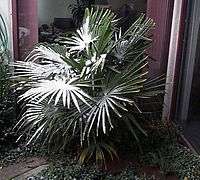 Trachycarpus fortunei Dusted with snow, in Grand Junction, Colorado
Trachycarpus fortunei Dusted with snow, in Grand Junction, Colorado Rhapidophyllum hystrix In Silver Spring, Maryland
Rhapidophyllum hystrix In Silver Spring, Maryland015.jpg) Chamaerops humilis
Chamaerops humilis- Washingtonia robusta
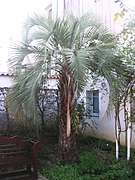 Butia odorata In France
Butia odorata In France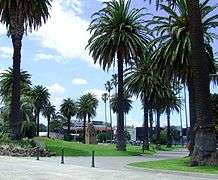 Phoenix canariensis In Melbourne, Australia
Phoenix canariensis In Melbourne, Australia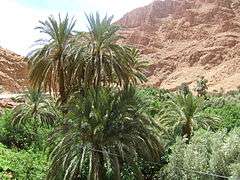 Phoenix dactylifera Planted in Morocco
Phoenix dactylifera Planted in Morocco
References
- Reichgeld, Tammo; West, Christopher K.; Greenwood, David R. (16 March 2018). "The relation between global palm distribution and climate". Scientific Reports. 8 (1): 4721. Bibcode:2018NatSR...8.4721R. doi:10.1038/s41598-018-23147-2. ISSN 2045-2322. PMC 5856843. PMID 29549297.
- "Connecticut's Notable Trees".
- "Connecticut's Notable Trees".
- Soares, Kelen Pureza (2015). "Le genre Butia". Principes (in French). 1: 12–57. Retrieved 17 September 2018.
- Wunderlin, R. P.; Hansen, B. F.; Franck, A. R.; Essig, F. B. (16 September 2018). "Butia capitata - Species Page". Atlas of Florida Plants. Institute for Systematic Botany, University of South Florida, Tampa. Retrieved 17 September 2018.
Recent taxonomy suggests B. odorata is the species naturalized in Florida, which has globose fruits, small midrib bundles completely encircling the fibrous cylinder, and does not have raphide-containing idioblasts in the foliar margin, unlike B. capitata (Sant’Anna-Santos et. al 2015)
- "Butia eriospatha - Palmpedia - Palm Grower's Guide". www.palmpedia.net. Retrieved 2019-05-24.
- "Connecticut's Notable Trees".
External links
- Palm Trees in Russia
- Højgaard, A., Jóhansen, J., & Ødum, S. (1989). A century of tree planting on the Faroe Islands. Ann. Soc. Sci. Faeroensis Supplementum 14.
- Cold Hardy Palms in Ohio